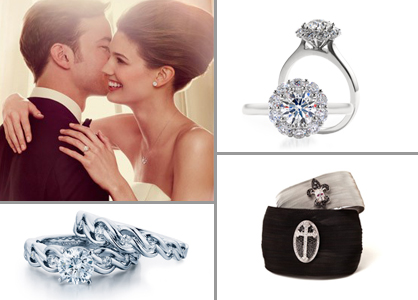Fine jewelry industry shows surprising growth
Today’s jewelry shopper is less worried about the struggling economy and more likely to whip out that credit card, reported WWD. The return of women to the market particularly has translated into impressive gains in sales, with double-digit growth at both fine jewelry trade shows and retailers such as Tiffany & Co. (up 20 percent) and Kay Jewelers (up 10.2 percent).
“The upper end of the market has come back because it is increasingly OK to shop again,” Greg Kwiat, chief financial officer of Kwiat and CEO of Fred Leighton, said to WWD.
He predicts Kwiat’s sales from the Couture show at the Wynn resort “will be up at least 20 to 25 percent this year. Retailers anticipate the higher end of the market being there this holiday.”
Mimi So, creator of a high-end jewelry brand that exhibited at Couture, is also witnessing an increase in sales, expecting to see her brand double its U.S. store door count before the year’s end.
“We have seen familiar faces that have signed on with us this year,” So reported. “They were holding off waiting for the economy to perk up and we’re moving through their inventory, and they want to introduce new designs.”
As ever, companies are returning to advertising to draw in sales. Already having raked in $200 million of retail sales since its founding in 2009, Forevermark – a De Beers Group diamond brand – is launching an extensive print and online ad campaign to drive its introduction into the U.S. market, where it intends to open 300 stores.
“We will be the single biggest diamond advertiser in the marketplace,” Sally Morrison, chief marketing officer for Forevermark, remarked, while declining to share the exact financial details of the campaign.
The World Gold Council – the gold industry’s trade organization—is also aggressively marketing its goods, commencing a “Gold Makes It Marriage” advertising effort designed to convince consumers of the importance of gold in celebrating marriages. Appearing in newspapers and magazines starting in July, the campaign will cost the organization more than $6 million.
However, the jewelry industry isn’t out of the woods yet. The price of gold and silver continues to soar, forcing jewelers to increase their prices for retailers at shows – such as the JCK show at Mandalay Bay and the Couture show—by 10 to 20 percent to maintain profit margins. While many believe that the hikes won’t impact high-end consumers’ demand for extremely costly items, a number of jewelers are concerned that the middle- and lower classes’ spending on lower-priced goods will wane.
Troubled economic times have led many jewelers to offer a variety of price points, especially options for $5,000 or less. For example, Temple St. Clair has doubled the number of pieces it sells for between $1,500 and $2,000 in its core collections.
Suneera Swarup, the designer behind Meus Designs, has found that the optimal range is $200 to $3,000 for her blackened silver and 18-karat gold accessories.
“I want to make a bridge between serious fine jewelry that can be worn every day, so there’s value, yet it’s fun,” she said.
The name of the game is affordability. Emily Cohen, director of public relations at JudeFrances, reported a shift from retailers regularly making purchases of $100,000 in 2007 to today’s orders, which are more likely to come in at $30,000. Luxury jeweler Alberto Parada has also witnessed orders drift toward more inexpensive pieces. Thus, more and more retailers are more cautious in purchasing, choosing to buy a few pieces rather than the whole line, he maintained.
“The idea is to sell seven or eight pieces at a price point and one or two at the higher end,” he said.
When it comes to pricing, some jewelers are headed in the opposite direction, however, deciding to up their charges to go after greater profit. For instance, Irene Neuwirth recently released a line of diamond jewelry at Barneys New York that retails for between $15,000 and $200,000. In spite of the hefty price tags, she sold 16 pieces in just 10 days.
“I have no desire to go to a lower price point. I just want to go higher,” said Neuwirth. “I think that made my brand stand out because a lot of people went lower and the market got flooded.”
Plagued with soaring costs of materials, jewelry companies have responded by reducing the amount of gold in pieces and mixing in less expensive materials.
Paul Schneider, who vends Yossi Harari’s line at his jewelry stores in the Northwest, believes jewelers are “getting creative.”
“(Harari is) adjusting his metals and using less gold without making everything less interesting,” Schneider said.
Many firms have turned their attention to bridal collections in order to turn a profit. But the bridal industry has also taken a hit. Nareg Kitsinian of Vanna K, a major jewelry brand that draws 85 percent of its sales from bridal, has seen more couples gravitate toward smaller stones in engagement rings.
“People want to see lower price points. The one carat in the past year has been where the demand is and even below,” he said.
Tagged in: jewelry, couture, market, advertising, sales, jck, jewelers, jewelry industry,

Purple Neon/LadyLUX via WWD



